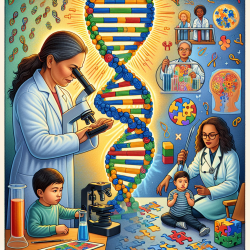Introduction
The complex world of neurodevelopmental syndromes often presents unique challenges for practitioners, especially when it comes to understanding the full spectrum of associated conditions. The recent study on the ophthalmic manifestations of NAA10 and NAA15-related syndromes offers invaluable insights into the prevalence and implications of visual impairments in these patients. By delving into this research, practitioners can enhance their skills and improve outcomes for affected children.
Understanding the Research
The study titled "Ophthalmic Manifestations of NAA10-Related and NAA15-Related Neurodevelopmental Syndrome: Analysis of Cortical Visual Impairment and Refractive Errors" provides a comprehensive analysis of the prevalence of ophthalmic conditions such as cortical visual impairment (CVI), myopia, astigmatism, strabismus, nystagmus, and hyperopia in patients with NAA10 and NAA15 mutations. The findings reveal a higher prevalence of these conditions in the NAA10 cohort compared to existing literature, suggesting potential underdiagnosis.
Key Findings and Implications
- The study identified a significant overlap in ophthalmic conditions between NAA10 and NAA15 cohorts, with no statistically significant differences, highlighting the need for comprehensive screening across both groups.
- Early ophthalmologic evaluations and interventions were underscored as critical for optimizing mobility, intellectual development, and overall quality of life.
- The research emphasizes the importance of understanding the specific ophthalmic manifestations of NAA10 and NAA15 mutations to improve clinical management and patient care.
Implementing the Research
For practitioners, integrating the findings from this study into clinical practice can lead to better diagnostic and therapeutic strategies. Here are some actionable steps:
- Ensure regular and thorough ophthalmologic screenings for patients diagnosed with NAA10 or NAA15-related syndromes.
- Collaborate with multidisciplinary teams to address the visual and developmental needs of these patients comprehensively.
- Stay informed about the latest research and advancements in the field to continually refine and improve patient care strategies.
Encouraging Further Research
While this study provides significant insights, it also highlights the need for further research to fully understand the ophthalmic implications of NAA10 and NAA15 mutations. Practitioners are encouraged to engage in ongoing research efforts and contribute to expanding the knowledge base in this area.
To read the original research paper, please follow this link: Ophthalmic Manifestations of NAA10-Related and NAA15-Related Neurodevelopmental Syndrome: Analysis of Cortical Visual Impairment and Refractive Errors.










